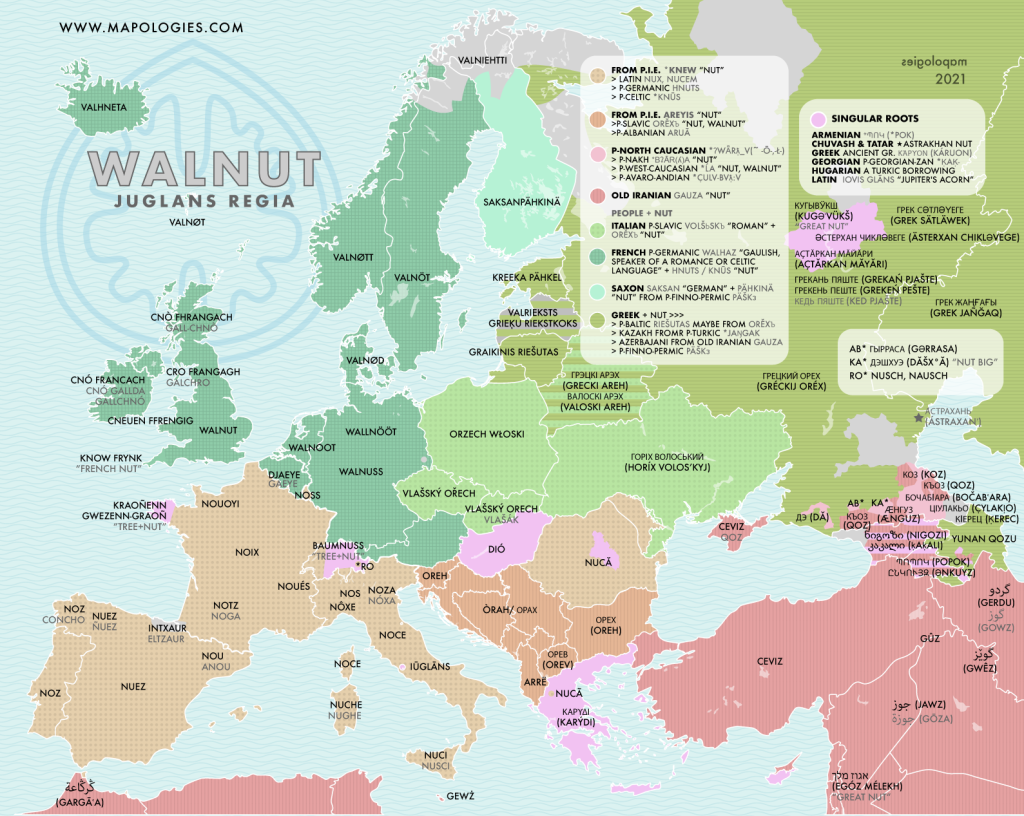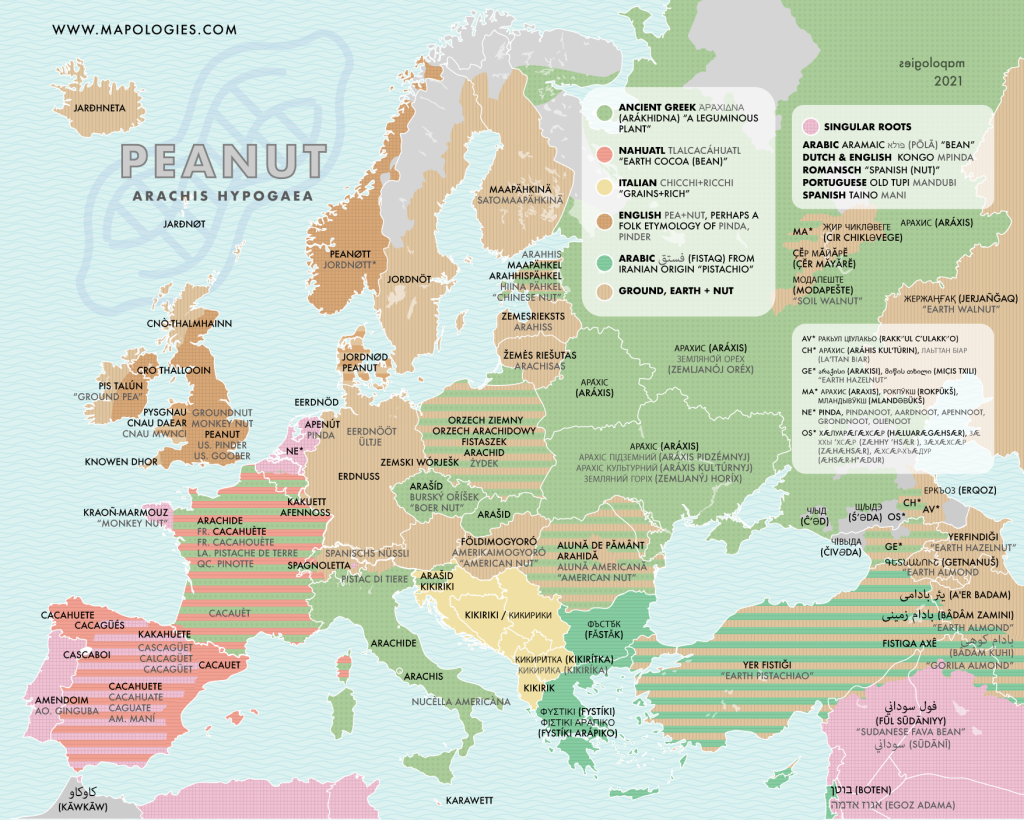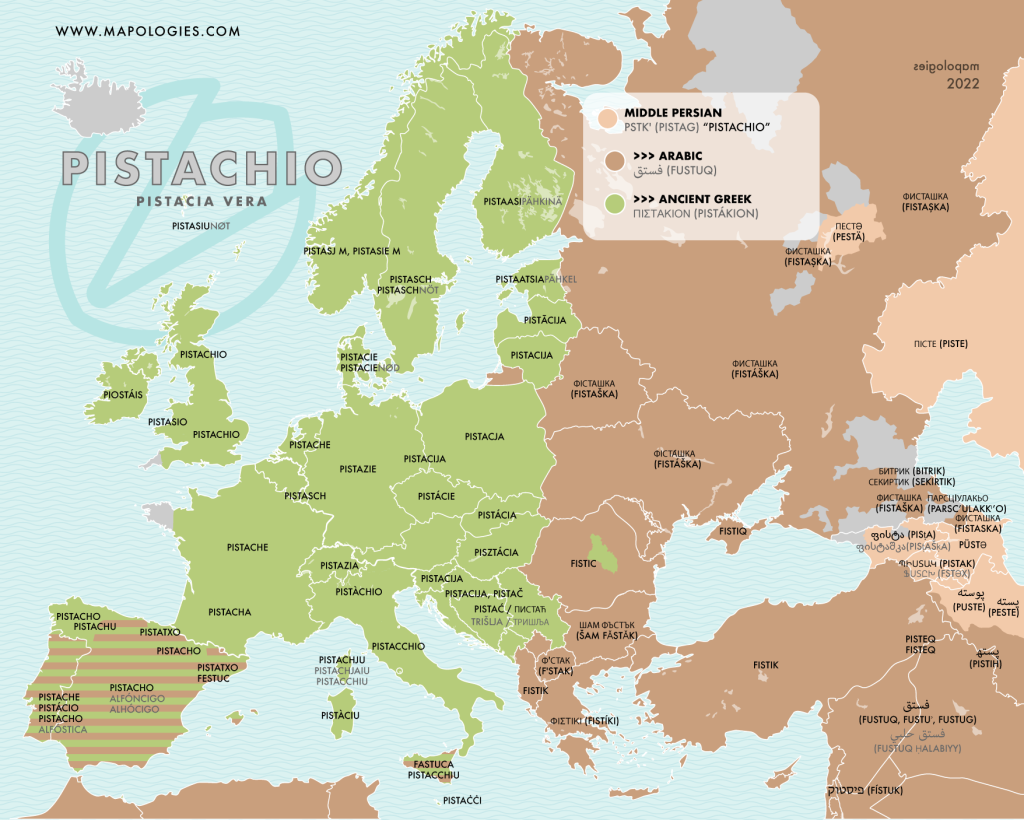Nuts are in our everyday language a variety of edible seeds or fruits enclosed in a hard shell. For most people, “nuts” typically encompass a wide range of items including almonds, walnuts, pecans, cashews, pistachios, hazelnuts, and also peanuts, which, despite their name, are technically legumes.
Botanically speaking, a nut is a type of fruit with a hard shell that does not split open to release its seeds. It develops from the ovary wall of a flower and contains a single seed inside. True nuts include acorns, chestnuts, and hazelnuts. Interestingly, almonds, walnuts, and pecans are not true nuts botanically; they are classified as drupes, which are fruits with a hard shell enclosing a seed or kernel.
Hazelnut

The hazelnut, fruit of the hazel tree or shrub belonging to the genus Corylus, derives its name from the Proto-Indo-European root *kóslos, modern Celtic and Germanic languages inherited and Finnish borrowed from the latter. On the other hand, Baltic and Slavic peoples used a different root, Proto-Indo-European *h₁loǵ-eh₂, likely originally denoting “branch” or “log.”
From the language of the Romans appeared two roots for hazelnut: one indicating “little nut” (Nuceola) and the other associating it with Avella, Italy, (Nux Abellāna). These roots dispersed in varying ways throughout modern Romance languages. Avella isn’t the sole city laying claim to hazelnuts’ origin. In contemporary Turkey, the Ancient Greek region of Pontus gave rise to the term Ποντικόν κάρυον (Pontikón káruon), meaning “Pontic nut.” This name has spread across numerous lands through centuries and linguistic shifts, now encompassing North Africa, Eastern Europe, and the Near East.
Walnut

Back in the Byzantine days, walnuts were known as the “king of nuts.” For Germanic speakers, they were dubbed “Welsh nut” owing to their journey from Italy through France. Interestingly, “wal” originally denoted anyone speaking a foreign language, be it Romance or Celtic. This linguistic nuance influenced the naming of walnuts. Romance languages simply term them “nut,” a designation adopted by South Slavic peoples as well. Among other Slavic languages, a divergence exists: some in the West refer to them as the “Italian nut,” while those in the East favor the “Greek nut.“
Curiously, despite being introduced to North America by Spanish missionaries, these nuts are known as “English Walnuts” in the United States.
Peanut

Arachis hypogaea, commonly known as the peanut, presents an intriguing botanical classification conundrum: is it a pea or a nut? In botanical terms, peanuts are classified as legumes, akin to beans, soybeans, chickpeas, and lentils. This distinction highlights the enduring nature of questions surrounding the peanut’s categorization, which dates back through history. Throughout time, peanuts have often been mistaken for cacao, pistachios, and beans due to their similar appearance.
Native to South America, the peanut has left its linguistic mark on various languages. Europeans borrowed terms to name the plant from indigenous American languages, Spanish from Nahuatl (and Taino), and Portuguese from Tupi. Later, as cultivation spread to Africa and Asia, languages like Dutch & English adopted the term “pinda,” derived from”mpinda “, from an African language called Kongo.
In English, alongside “peanut” and “pinda”, the term “groundnut” is also used, mirroring compound nouns found in many other languages (as indicated in light brown on the map). However, the most prevalent linguistic root for “peanut” traces back to the Greek word “ἄρακος” (árakos), denoting a leguminous plant, likely initially referring to Lathyrus annuus. Interestingly, this term not only found similarity with peanuts but also with Pistacia vera, commonly known as pistachio. In Bulgarian and Greek, the word for peanut remains the same, while Turkish distinguishes it as “earth pistachio.”
Pistachio

Chestnut

Coconut

In 1280 Marco Polo saw for the first time a strange big nut in Sumatra. The Arabs already knew it and called it jawz hindī (جوز هندي), which the Italian explorer translated literally to Latin as nux indica, the Indian nut. This name is still present in many languages (yellow on the map).
Two centuries later the explorer Vasco da Gama created a new name much more exotic: Coco. Because it resembles the traditional Portugues Jack-o’-lantern, a pumpkin with three holes, that represents the face of a mythical monster, similar to the bogeyman. The word coco might refer to the head or the skull. Then in Europe, some languages added the nut, however botanically speaking, this fruit is a drupe, not a true nut.
The languages in violet have unique roots. For example, Dutch Klappernoot was borrowed from Indonesian kelapa. Netherlands colonized Indonesia and it is also one of the regions where coconuts are originally from.
Some small languages have great names: In Manx is called Nut Milk (Cro Bainney). Coconut milk is a milky-white liquid extracted from the grated pulp. In Moksha is sea nut (иневедень пяште, ineveden’ pjašte). Because coconuts are light and water-resistant, they disperse via marine currents. It is said that they can travel 110 days or 5,000 kilometers. Thanks to both characteristics coconuts played a key role in the early migrations of the Austronesian peoples, and later, for the commercial routes to Africa the Caribean.
Cashew

The cashew tree (Anacardium occidentale) is a tree with a deep connection to Portugal. This tropical evergreen tree is not originally from there, however. It grew in the northeast of modern Brazil, back then a Portuguese colony of Portugal. For this reason, Azerbaijani calls it “Brazilian nut”.
On the other hand, some languages (on the map colored in green) say “Indian nut”. This is because between 1560 and 1565 cashew nuts were shipped to another Portuguese colony, Goa, where the weather conditions were similar. It spread all over the Indian subcontinent and other parts of Southeast Asia, where it became part of the traditional cuisine: for example, the liquor Feni and the Philipino sweet Turrones de casuj. Later it was taken to West Africa and finally to East Africa.
Its products are the cashew apple (an accessory fruit or pseudofruit), but especially the cashew seed, called cajú or acajú. Portuguese explorers took the name from Old Tupi acajú, which translates as “the fruit that produces itself”, and brought it to Europe.
However, not all languages adopted the original name. Body organs are common metaphors: Lithuanian and many Romance languages also use the scientific name form Greek anakardia (ἀνάκαρδία), meaning “on/upon the heart”, due to the heart-shaped pseudofruit. Polish, on the other hand, do not see any heart but a kidney, orzech nerkowca means “kidney-shaped”.
Almond

Acorn

Nutmeg




